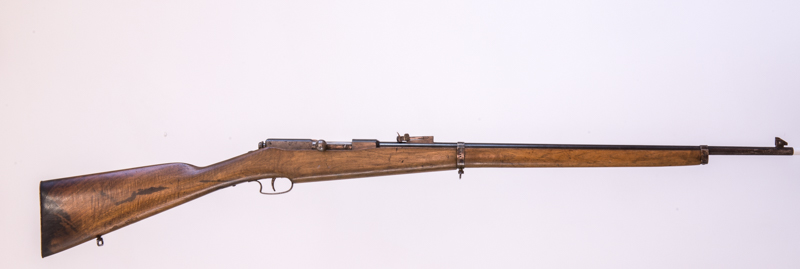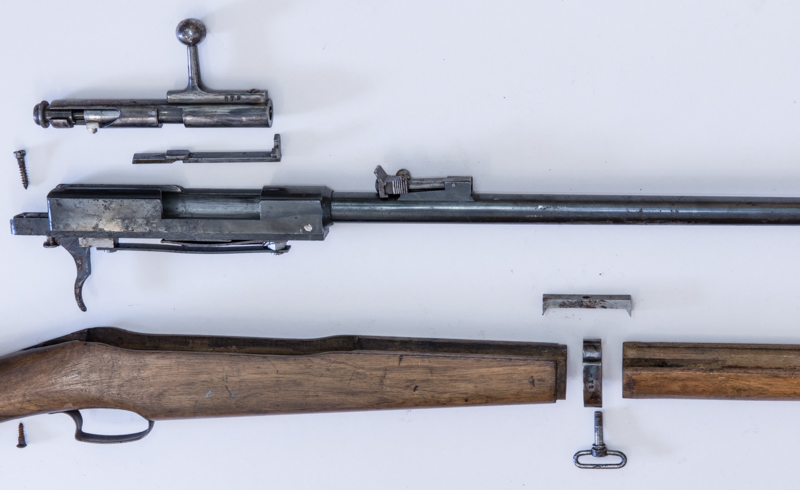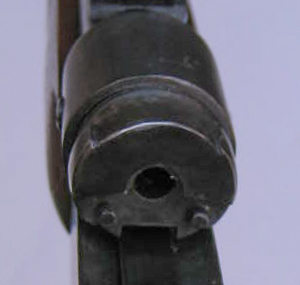The "NATIONALE RIFLE"
Please be aware that some specialist imagery may take time to load.
This site is for dedicated researchers and is best viewed on desktop.
See also the Lebel Training Rifle by Demay
or the fine Pidault Lebel model plus two more Lebel style Training Rifles
A "Cadet and School" Training Rifle
by "Manufacture d'Armes Damon et cie, St Etienne" ?
This model is not marked with any manufacturer's name, but other similar, although possibly earlier, examples of the "Nationale Rifle" have been reported as carrying the name of the maker shown in our page heading.
The next two images can be rotated and zoomed, either as initially loaded or full-screen for higher definition.
Bolt locking is achieved by the rotation of the bolt handle rib down against the rear shoulder of the receiver bridge.
There is a fine vertical groove machined into the right-hand-side of thestock, just forward of the trigger-guard, to accommodate the bolt handle's stem in its vertically closed position.
DATA TABLE - ALL MEASUREMENTS AS VIEWED EXAMPLE
FIREARM
IMPERIAL
(METRIC)
Designation or Type :
Military Style Cadet Rifle
Manufacturer :
Possibly "Manufacture d'Armes Damon et cie, St Etienne"
Date :
ca 1930
Serial No :
5572
Furniture :
Walnut
Action Type :
Turning bolt
Nomenclature or main marks:
"Nationale Rifle"
Calibre :
.22RF
-
Weight :
5 lbs. 6⅔ ozs.
2.46 kgs
Length - Overall :
43½ inches
110.5 cms
Length - Barrel :
25 inches
64.7 cms
Pull :
13 inches
33.6 cms
Spare row :
-
Rifling - No. of Grooves :
6
tight bore slugged at 0.221"
Rifling - Twist & Direction :
1 turn in 16¼ inches - RH
1 : 41.2 cms
Rifling - Groove width :
inches
mm
Rifling - Land width :
inches
mm
Rifling - Groove depth at muzzle :
inches
mm
Sight - Fore :
long circular bead
Sight - Rear :
Tangent leaf with v.fine U-notch
-
Sight - Radius :
22 inches
56 cms
Imagery of the 8mm full-bore Berthier service rifle can be viewed HERE for comparison.
The disassembled parts image below illustrates a number of points. Firstly, apart from the external profile of the receiver and the bolt's cocking-piece arrangement, the remainder of the rifle is constructed with parts that appear, to all intents and purposes, identical with parts of the as yet unidentified Lebel-style training rifle on we show on another page.
The rear-sight, with its windage adjustment, the barrel, barrel bands and fore-sight are certainly all from the same stable. One major difference, though, is the two-part fore-end wood, which has a steel linking piece with wedged lugs. This part is let into the barrel-groove in the wood, and is drilled and threaded to take the combination bedding bolt/sling-swivel which, in common with the aforementioned Lebel trainer, does not fasten into the underside of the barrel, but does locate the rear barrel-band.
Over the time this 6mm rifle model was manufactured, the 9mm model was still available,
with a third option of 5.5mm ' Extra-courte' (22in. Extra Short) chambering.
The example above is marked ".22." on the barrel-LHS immediately behind the tangent rear-sight.
Below is the rifle shown on a page from a 1951 catalogue.
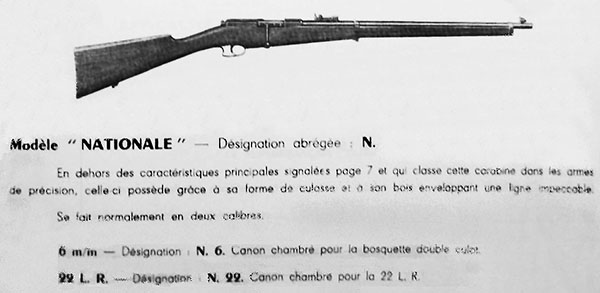
Offered were rifles chambered for the "Double Culot" (double base) 6mm 'Bosquette' cartridge, and for the .22"RF Long Rifle cartridge. The ammunition was then priced at ?? francs per 250 rounds, and the rifle at ?? francs; this when 1 franc was approximately the equivalent of ??p. Thus the rifle cost £?, and the ammunition about ?? new pence per round.
A "Cadet and School" Training Rifle
by "Manufacture d'Armes Damon et cie, St Etienne" ?
This model is not marked with any manufacturer's name, but other similar, although possibly earlier, examples of the "Nationale Rifle" have been reported as carrying the name of the maker shown in our page heading.
A "Cadet and School" Training Rifle
by "Manufacture d'Armes Damon et cie, St Etienne" ?
This model is not marked with any manufacturer's name, but other similar, although possibly earlier, examples of the "Nationale Rifle" have been reported as carrying the name of the maker shown in our page heading.
The next two images can be rotated and zoomed, either as initially loaded or full-screen for higher definition.
Bolt locking is achieved by the rotation of the bolt handle rib down against the rear shoulder of the receiver bridge.
There is a fine vertical groove machined into the right-hand-side of thestock, just forward of the trigger-guard, to accommodate the bolt handle's stem in its vertically closed position.
DATA TABLE - ALL MEASUREMENTS AS VIEWED EXAMPLE |
||
FIREARM |
IMPERIAL |
(METRIC) |
| Designation or Type : | Military Style Cadet Rifle
|
|
| Manufacturer : | Possibly "Manufacture d'Armes Damon et cie, St Etienne" |
|
| Date : | ca 1930 |
|
| Serial No : | 5572 |
|
| Furniture : | Walnut
|
|
| Action Type : | Turning bolt
|
|
| Nomenclature or main marks: | "Nationale Rifle"
|
|
| Calibre : | .22RF |
- |
| Weight : | 5 lbs. 6⅔ ozs. |
2.46 kgs |
| Length - Overall : | 43½ inches |
110.5 cms |
| Length - Barrel : | 25 inches |
64.7 cms |
| Pull : | 13 inches |
33.6 cms |
| Spare row : | - |
|
Rifling - No. of Grooves : |
6 |
tight bore slugged at 0.221" |
| Rifling - Twist & Direction : | 1 turn in 16¼ inches - RH |
1 : 41.2 cms |
| Rifling - Groove width : | inches |
mm |
| Rifling - Land width : | inches |
mm |
Rifling - Groove depth at muzzle : |
inches |
mm |
| Sight - Fore : | long circular bead
|
|
| Sight - Rear : | Tangent leaf with v.fine U-notch |
- |
| Sight - Radius : | 22 inches |
56 cms |
Imagery of the 8mm full-bore Berthier service rifle can be viewed HERE for comparison.
The disassembled parts image below illustrates a number of points. Firstly, apart from the external profile of the receiver and the bolt's cocking-piece arrangement, the remainder of the rifle is constructed with parts that appear, to all intents and purposes, identical with parts of the as yet unidentified Lebel-style training rifle on we show on another page.
The rear-sight, with its windage adjustment, the barrel, barrel bands and fore-sight are certainly all from the same stable. One major difference, though, is the two-part fore-end wood, which has a steel linking piece with wedged lugs. This part is let into the barrel-groove in the wood, and is drilled and threaded to take the combination bedding bolt/sling-swivel which, in common with the aforementioned Lebel trainer, does not fasten into the underside of the barrel, but does locate the rear barrel-band.
Over the time this 6mm rifle model was manufactured, the 9mm model was still available,
with a third option of 5.5mm ' Extra-courte' (22in. Extra Short) chambering.
The example above is marked ".22." on the barrel-LHS immediately behind the tangent rear-sight.
Below is the rifle shown on a page from a 1951 catalogue.

Offered were rifles chambered for the "Double Culot" (double base) 6mm 'Bosquette' cartridge, and for the .22"RF Long Rifle cartridge. The ammunition was then priced at ?? francs per 250 rounds, and the rifle at ?? francs; this when 1 franc was approximately the equivalent of ??p. Thus the rifle cost £?, and the ammunition about ?? new pence per round.
(We await confirmation of the above prices)
"Manufacture d'Armes Damon et cie, St Etienne"
The action and rear-sight, viewed from above.

The tangent rear-sight is calibrated 25-50-100-200 metres, and the elevation slide moves along a smooth ramp. The finely "U'-notched rear plate is windage adjustable by slackening its clamping screw at rear centre. The barrel calibre mark of ".22." is just behind the rear-sight. The serial number is clearly stamped on the receiver ring "5572".
The mark immediately above that is the French "BTE S.D.G.D.", which abbreviates the French term "Bréveté - Sans Garantie Du Gouvernment", advising that the rifle carries no Government guarantee; an indication that it is not of military issue.
The rifle was one of many of French manufacture that were approved for use by the cadets and clubs of the "Societé Nationale de Tir" (National Shooting Society) of France. This was the approximate equivalent of the British Society of Miniature Rifle Clubs.
The action body and trigger mechanism
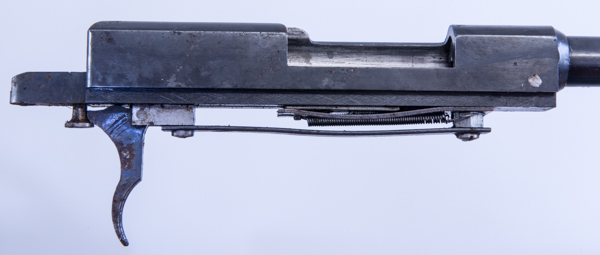
The action from the left-hand-side
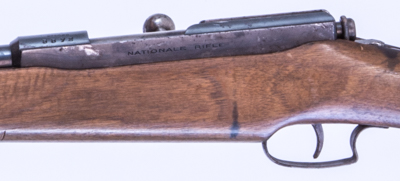
The bolt recessed for the cartridge-case head
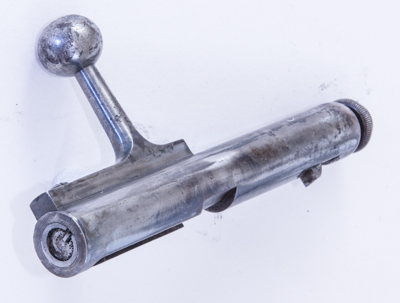
and from beneath
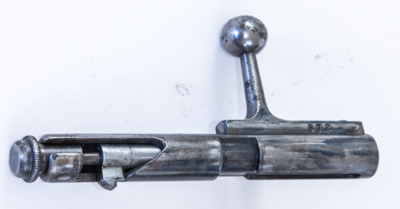
Both the foresight and front barrel-band are of the same type as the previously mentioned unmarked Lebel-type training rifle. The band is simply attached with a screw underneath into the woodwork; thus the barrel is effectively the only means of support for the fore-end's forward section.

Those two cartridges recommended for the "Nationale Rifle" were the 6mm Flobert of the Bosquette system - with conical bullet - intended for ranges up to 25 metres, and the similar 6mm "Nationale" cartridge, also double-based and 'percussion annulaire' (rimfire) - with round-nosed bullet -for ranges up to 40 metres. The later .22RF Long-Rifle cartridge, had a stated maximum suitable range of 150 mtrs.
Three images of the breech, muzzle and rifling are shown below.
CLICKING ON THE CENTRE IMAGE WILL SHOW
A SHORT VIDEO CLIP OF A PASSAGE THROUGH THE BORE
Below is an image of a lead slug - in the form of a .22 bullet - that has been passed through this barrel.
The very slightly slanted indentation from a land is in the centre, and the compression of the bullet in the grooves can be seen either side,
where it is just possible to discern the original twin peripheral rows of indentations which held lubricant on the driving band.
See the measurements data table shown earlier on the page for dimensions
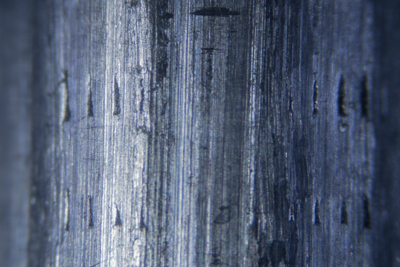
Above - the bore's land impression on a .22LR bullet.
Return to: TOP of PAGE
See this website's Raison d'être

